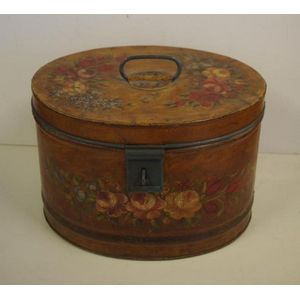Inlaid Satinwood Tea Caddy, George III, 1790
A George III oval inlaid satinwood tea caddy, circa 1790 the top inlaid with flower head paterae, brass handle, the sides decorated with amphora, swags and foliate motifs, the interior with original tin lining and key 12 cm high, 19.5 cm wide, 14.5 cm deep
You must be a subscriber, and be logged in to view price and dealer details.
Subscribe Now to view actual auction price for this item
When you subscribe, you have the option of setting the currency in which to display prices to $Au, $US, $NZ or Stg.
This item has been sold, and the description, image and price are for reference purposes only.
- Circa - A Latin term meaning 'about', often used in the antique trade to give an approximate date for the piece, usually considered to be five years on either side of the circa year. Thus, circa 1900 means the piece was made about 1900, probably between 1895 and 1905. The expression is sometimes abbreviated to c.1900.
- Foliate - Decorated with leaves or leaf-like forms.
- George Iii - George III (1738 - 1820) was King of Great Britain and Ireland from 1760 to 1820.
- Satinwood - Satinwood is a dense pale gold coloured timber that was imported into Britain in the second half of the 18th century, and early 19th centuries from the East Indies and the West Indies. The name derives from the satin-like surface sheen when the timber is polished.
It was used in the solid, as a veneer and in inlays. As well as furniture, satinwood was used for making musical instruments, barometers, boxes and clocks.
It will usually be found on only the very best quality objects, presumably because of of its cost at the time. - Floral Swag / Garland / Festoon - Floral swags are a decorative motif often used in the ornamentation of various objects, such as silverware, glassware, and furniture. The term "swag" refers to a garland or wreath of flowers, foliage, or other decorative elements, which is usually arranged in a loop or curve.
Floral swags can be found in a variety of decorative styles, from ornate Baroque and Rococo designs to more naturalistic Art Nouveau and Art Deco styles. They are often used to add a touch of elegance, refinement, or whimsy to an object, and can be seen on a range of items from chandeliers and candlesticks to picture frames and tea sets.
In the decoration of silver objects, floral swags are often used to accentuate the curves and lines of the piece, and to add visual interest to the surface. Similarly, on glass objects, floral swags may be used to frame or highlight a particular area of the object, or to add a touch of color and delicacy.
On furniture, floral swags can be found on a variety of pieces, from cabinets and armoires to chairs and sofas. They are often used to enhance the lines and curves of the furniture, and can be used to create a sense of movement and flow in the design.
Overall, floral swags are a versatile decorative element that can be adapted to a range of styles and applications, and have been used in the decoration of various objects throughout history.
This item has been included into following indexes:
Visually similar items

Antique style tin hat box with folk art decoration, 34 cm wide
Sold by
in
for
You can display prices in $Au, $US, $NZ or Stg.

Antique faux wood tin hat box, approx 25 cm high, 38 cm wide, 29 cm deep
Sold by
in
for
You can display prices in $Au, $US, $NZ or Stg.

Jens Quistgaard for Dansk Denmark, 1950s teak ice bucket, with original liner
Sold by
in
for
You can display prices in $Au, $US, $NZ or Stg.

A Qing-period terracotta jar, with impressed decoration of eight gods to the walls and a Buddhist figure to the lid, Xianfeng reign mark impressed under the base. Height 10 cm
Sold by
in
for
You can display prices in $Au, $US, $NZ or Stg.
